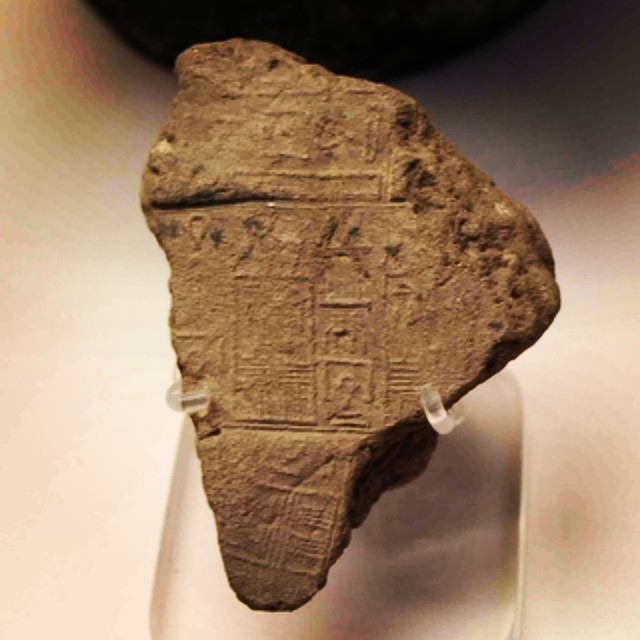
Ancient Egyptian hieroglyphs were commonly etched into stone and used in temples, tombs, and other monuments, with the first fully formed sentence found around 2800 BC. The word “hieroglyphs” comes from the Greek adjective “hieroglyphikos,” meaning “sacred carving.”
Early forms of ancient Egyptian hieroglyphs existed before this time, however, with some experts claiming that the writing system may have its origins in artistic symbols used on Gerzean pottery from around 4000 BC. Some of this resemble the hieroglyphs we know today.

Proto-hieroglyphic (the earliest form) symbol systems developed in the latter half of the 4th millennium BC. Examples of such can be seen on the clay labels of predynastic ruler Scorpion I, discovered at Abydos (modern-day Umm el-Qa’ab, Egypt) in 1988, and the Narmer Palette, which dates back to roughly 3100 BC.
The first full sentence etched in mature ancient Egyptian hieroglyphs, thus far discovered, was found on a seal impression in the tomb of Seth-Peribsen at Umm el-Qa’ab. This has been carbon dated back to around 2800 BC.

Approximately eight hundred hieroglyphs are known to date back to the Old Kingdom, Middle Kingdom, and New Kingdom periods. By the Greco-Roman era, there were more than five thousand.
Why Were Ancient Egyptian Hieroglyphs Invented?
Although, approximately, it is known when ancient Egyptian hieroglyphs emerged as a writing system, there is still an immensely important question as to why they were invented. Some experts argue the reason for their invention had to do with Egypt’s unification into a single state and administration. This coincided with the emergence of the writing form.
“It is logical that a state of Egypt’s size and complexity required a flexible system of accounting that could keep information on the nature of goods, their quantities, provenance and destination, the people in charge of them and the date of transaction,” Marc Van De Mieroop, a history professor at Columbia University wrote in his book, A History of Ancient Egypt.
However, the author does also stress that ancient Egyptian hieroglyphs might well have been invented to help glorify gods and the king, pointing out that some of the earliest carvings depicting ancient Egyptian kings contain hieroglyphs. “The glorification of the king may have been one of the driving forces in the script’s invention,” he wrote.
Ancient Egypt’s contact with another ancient society, that of Sumerian Mesopotamia, may have been the origin of writing in the modern-day African country. Some experts believe that ancient Egyptian hieroglyphs came into existence not long after Sumerian script and thus were likely invented under the influence of the latter.

It has also been suggested that the general idea of expressing words in writing came to Egypt from Sumerian Mesopotamia, given that there is lots of evidence for early Egypt-Mesopotamia contact. However, due to the lack of direct evidence for the transfer of writing, other researchers argue that no definitive conclusions can be made about the origin of hieroglyphs in ancient Egypt. Some maintain the writing form was developed independently by ancient Egyptians.
Ancient Egyptian Hieroglyphs Appeared Suddenly
Since the 1990s, many scholars have argued that the hieroglyphs discovered at Abydos, weaken the theory that the Mesopotamian symbol system predates the Egyptian one. The strangest part, however, is that ancient Egyptian hieroglyphs appeared suddenly at that time, whereas Mesopotamia had a long, gradual evolutionary history of sign usage for agriculture and accounting, mostly seen in tokens dating back as far as 8000 BC.
The Different Types of ‘Glyph’
Hieroglyphs contain three different types of ‘glyph.’ These include phonetic glyphs, which include single-consonant characters that function like an alphabet; logographs, which represent morphemes (the smallest meaningful constituent of a linguistic expression); and determinatives, which narrow down the meaning of logographic or phonetic words.
The Evolution of the Symbolic Writing System Over the Centuries
As writing was popularized throughout ancient Egypt, with its adoption by more and more people, more simple glyph forms began to develop. These resulted in the hieratic (priestly) and demotic (popular) scripts.
It could be said that these new forms were more suitable for writing on papyrus. The rise of more simplistic forms did not spell the end of hieroglyphs. Rather, all forms existed alongside each other. The Rosetta Stone is made up of three parallel scripts for instance, hieroglyphic, demotic, and Greek.
Ancient Egyptian hieroglyphs were even still in use during the era of Alexander the Great and under Persian rule (intermittent in the 6th and 5th centuries BC). Many comments and writings about ancient Egyptian hieroglyphs by ancient Greek and Roman writers have been misleading, and it is believed this happened as a response to the changing political situation. Some ancient thinkers claimed that the function of hieroglyphs was to distinguish between true Egyptians and foreign conquerors.
A different reason for the misleading comments around ancient Egyptian hieroglyphs may have sprung from the refusal of ancient Greeks and Romans to take ancient Egyptian culture on its own terms, Having discovered that hieroglyphs were sacred writings, Greco-Roman authors believed the symbol system to be magical, capable of transmitting mystical knowledge.
See all the latest news from Greece and the world at Greekreporter.com. Contact our newsroom to report an update or send your story, photos and videos. Follow GR on Google News and subscribe here to our daily email!



